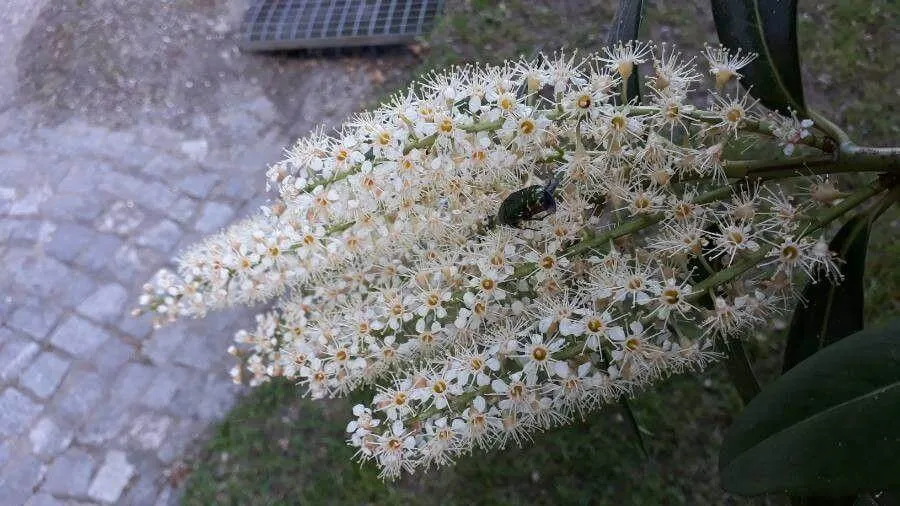Cherry Laurel: Discover how to care for it. Frost-resistant and low-maintenance yet elegant – the cherry laurel is the perfect solution for every gardening enthusiast.

Propagating, Pruning, Planting and Caring for Cherry Laurel
During my time caring for the cherry laurel, I learnt that the right soil, watering and pruning are so important for the plant's healthy development. The cherry laurel grows quickly and forms a beautiful green hedge, which is a real delight in my garden. It was an exciting process from planting to flowering, and it was a pleasure to see the cherry laurel become more attractive day by day.
The columnar cherry laurel, also known as Prunus laurocerasus, is a truly exceptional plant that many gardeners favour for its beauty and ease of care. But what varieties exist, and under what conditions does it truly thrive? In this article, we will answer these questions as well.
There are several varieties of the cherry laurel hedge, among which the most well-known are perhaps 'Otto Luyken' and 'Zabeliana'. The 'Otto Luyken' is compact, with low growth and dark green leaves, while 'Zabeliana' boasts long, narrow leaves. Both varieties produce white flowers and emit a pleasant fragrance.
But in what type of environment do these plants thrive best?
The cherry laurel favours moist, yet well-draining soil. In overly wet soil, root rot may occur, while in soil that is too dry, the plant's leaves can wither. It tolerates both sunny and semi-shaded spots, although its leaves may scorch under excessively strong sunlight. The ideal soil pH lies between 6.0 and 7.5.
It is best to plant the cherry laurel in spring or autumn when the soil is damp, but not too cold. Prior to planting, it is advisable to thoroughly loosen the soil so that the roots can spread easily. Plant it deeply to prevent the roots from drying out. But how often should you water the cherry laurel during planting?
You should water it regularly, but in moderation. The excess of water can cause root rot, while too little water will lead to the leaves drying out. It is advisable to prune the plant once a year to keep its shape neat.
When planting the cherry laurel, it is wise to keep the plant at a slightly elevated level so that the roots do not reach the soil. This helps prevent root rot. It tolerates pruning well, so you can confidently shape the plant according to your own taste.
Based on my personal experience, I recommend planting cherry laurel in groups to create a lush, green hedge. It grows quickly, so you will soon be able to enjoy the view it provides.
This is a truly exceptional plant that brightens any garden with its beauty and ease of care. If you haven’t tried it yet, it’s well worth a go – you won’t be disappointed. The cherry laurel, also known as Prunus laurocerasus, is a truly striking, evergreen plant that is often used as a hedge or standalone specimen in gardens.
Allow me to share with you my own experiences and advice.
Cherry laurel thrives in moist, yet well-draining soil. Watering should be adjusted according to the dryness of the soil, but generally once or twice a week is sufficient. Over-watering must be avoided, as it can lead to root rot. An interesting question is whether mulching can help maintain the proper moisture level. The answer is yes! Mulching, for instance with organic materials like compost or fallen leaves, helps retain soil moisture and prevents the growth of weeds.
Pruning is generally carried out in early spring when the plant is still dormant. The purpose of pruning is to shape the plant and remove any diseased, damaged or overly dense branches. A good tip: never prune branches thicker than the diameter of the plant's trunk! This prevents the plant from undergoing excessive stress.
Among the diseases of the cherry laurel are leaf spot, downy mildew and moniliasis. Among pests, aphids and scale insects are the most common. To prevent diseases, proper nutrient supply and regular watering are important. For pest control, biological agents such as insecticidal soap or neem oil can be very effective.
From personal experience: regular inspection of the leaves and early intervention help prevent major problems.
If you’d like to propagate cherry laurel at home, taking cuttings is one of the most reliable and effective methods. In early summer, select healthy, 10-15 cm long semi-woody shoots from the plant that are neither too young nor fully mature. Carefully cut the shoots with a sharp, sterilised pair of scissors, then remove the lower leaves to channel more energy into root formation.
Dip the cut end in a rooting hormone, which promotes faster and stronger root development.
Then plant the cuttings in moist, sandy soil that guarantees good drainage and moisture retention. Keep the cuttings in a warm environment, ideally in a warm, humid place, and make sure that the soil remains consistently moist. Within a few weeks, they will root, and over time, develop into new plants that you can later transplant into your garden.
If you would like to try growing cherry laurel from seeds, collect the ripe berries in autumn, then clean the seeds. Soak the seeds in water for 24 hours, then plant them in moist soil. Keep the soil moist and warm until the seeds germinate. This method is a bit more time-consuming, but can also be successful. Caring for cherry laurel is not a complicated task, but a few basic rules must be followed.
Proper watering, mulching, regular pruning and maintenance, as well as effective measures against diseases and pests, all contribute to the plant’s healthy growth and beautiful appearance. on the subject.